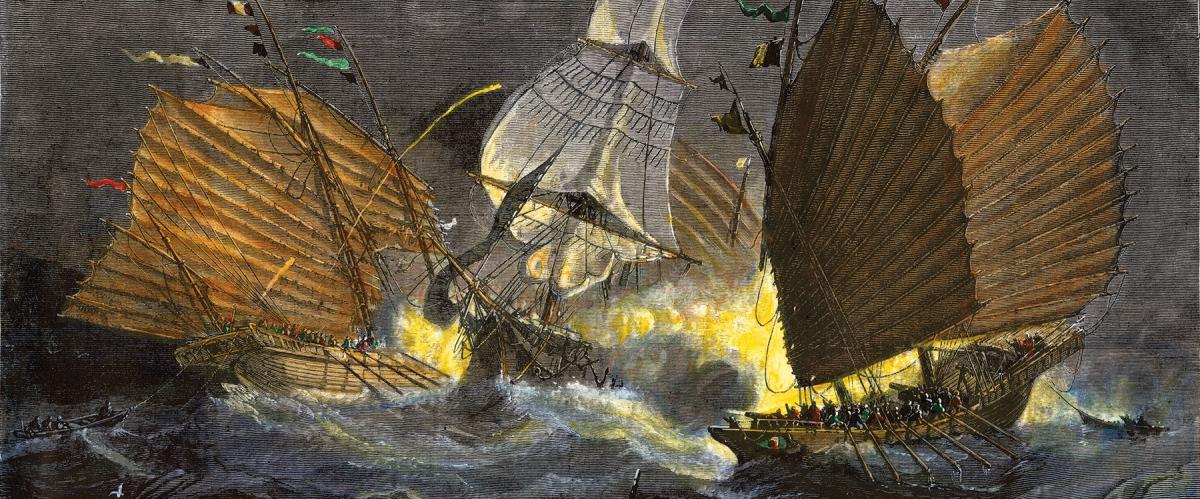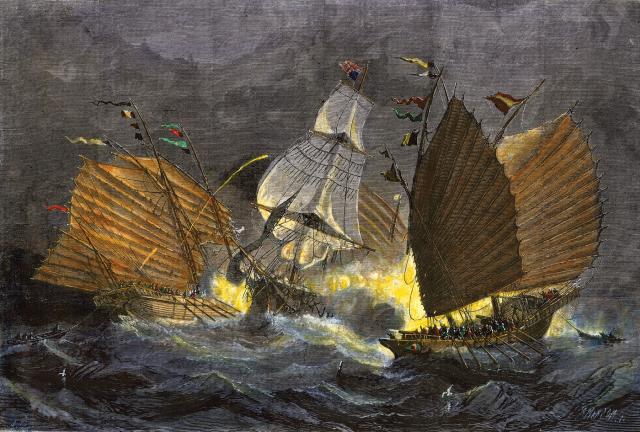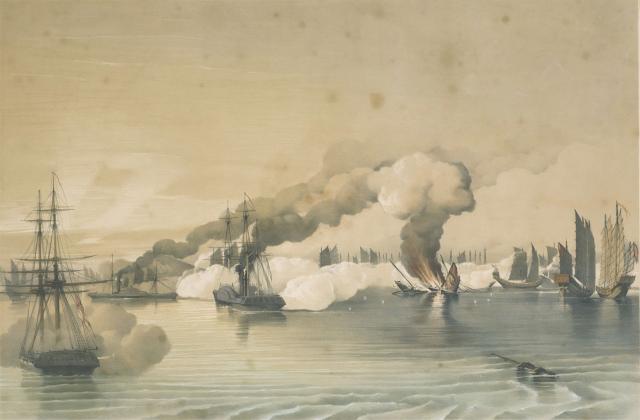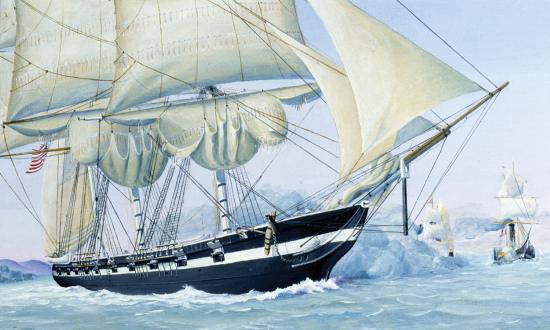The South China Sea has emerged as one of today’s maritime trouble spots, but these were dangerous waters in times past as well. In the 1840s, the South China Sea was a notoriously high-risk place to be. The powerful pirate chieftains Shap-ng-tsai and Chui-Apoo commanded great fleets of well-armed war junks and ruled the waves with destructive abandon.
Villages along the coast were constant victims of their attacks with fire and sword. Those engaged in fishing or seaborne trade regularly had to cough up blackmail money to stay afloat. The Chinese Navy was all but helpless against the might of the pirate fleets—which brazenly captured imperial ships and held officers and government officials ransom. As Royal Navy Commander John C. Dalrymple Hay observed, “The audacity of the pirates knew no bounds.”
Commander Hay was on China Station with a mission to crush the South China pirates once and for all. They had been a recurrent nuisance in the region for years, but as their numbers had grown bigger and their actions bolder, the situation had escalated far past the boundary of the tolerable. Chui-Apoo commanded a 50-junk fleet, while Shap-ng-tsai’s fleet numbered around 70, ranging from his 42-gun flagship down to 34-gun, 28-gun, 12-gun, and 6-gun vessels—a veritable armada of criminality.
The pirates’ increasing obstreperousness finally brought down the long-overdue heat. Chui-Apoo killed two British officers in February 1849. Shap-ng-tsai’s pirates sank two British merchant ships and an American merchant ship that spring, then assassinated and beheaded the Portuguese territorial governor in broad daylight later that summer. The hunt was now on in earnest.
Hay led the squadron that cornered and defeated Chui-Apoo’s fleet near Hong Kong in late September, but the pirate chieftain fled and some of his junks managed to scatter. The British ran them down and finished the job on 1 October. Once in British hands, Chui-Apoo would kill himself. One down, one to go.
Flying his flag in the sloop HMS Phlegethon, accompanied by the brig Columbine and sloop-of-war Fury, Hay went pirate-hunting again that October, joined by eight Chinese Navy junks, setting sail from Hong Kong and heading south along the coast, on the lookout for the elusive Shap-ng-tsai.
After three days, Hay’s force came upon a burned-out, corpse-strewn village. From survivors, the hunters got the story: The pirates had been there five days earlier. They had made off with many of the town’s women.
Continuing south, the Phlegethon ran into one of Shap-ng-tsai’s lookout junks, chased her down, and destroyed her. The hunters were getting closer. They continued south and on 19 October found out that the pirates were anchored several miles ahead in the Tonkin Gulf.
Hay and company chased after them and sighted them entering the mouth of the Tonkin River (aka the Red River). The hunters followed in pursuit and, at 1640 on 20 October 1849, found themselves face-to-face with the close-anchored line of Shap-ng-tsai’s formidable pirate fleet. “Two hundred and sixty-four guns were . . . bearing on the narrow entrance,” reported Hay.
Within minutes, the pirates unleashed an opening salvo. Their gunnery was off the mark at first, but as the Sino-British force closed the gap, the long 18-pounders of Shap-ng-tsai’s junks started to take their toll. But the counterfire of the squadron proved accurate and deadly, and before long several junks were sinking or on fire. Hay’s flagship charged the enemy line and shot it out with two pirate vessels, besting them both. The Fury attacked the line with ferocity as well, and before long had sent four more pirate ships to the bottom.
Then, less than half an hour into the battle, the hunters scored several hits on the biggest, highest-value target of them all: Shap-ng-tsai’s 42-gun flagship. “At about 5 p.m. the firing on both sides was maintained with spirit, when a shell from the Phlegethon blew Shap-ng-tsai’s junk bang into the air, crew and all, with a fearful explosion,” Hay recounted, “and on the smoke clearing away, scarcely a vestige of his proud flagship could be seen above water . . . amidst many explosions, the flag, until consumed by fire, continued to fly.”
It was all downhill for the pirate fleet after the loss of its flagship. “This magnificent spectacle was followed by the entire destruction by fire of the whole of the junks anchored in her vicinity,” noted Hay. “[A]fter dark the heavens reflected the havoc going on, no less than 27 of the largest junks being in flames, exploding right and left . . . their guns going off in all directions as they became heated. . . . The fires lasted till daylight.”
Half the pirates’ fleet had been obliterated, but still they fought. Remarkably, Shap-ng-tsai had survived his flagship’s destruction, and the slugfest continued on the 21st. But the tide of battle was against the pirates, and by the end of that second day’s fighting, 24 more of their junks were destroyed. Finally, “On the 22nd the completion of the destruction was resumed, and by sunset six more junks had shared the fate of their comrades, and the affair was over,” said Hay. “No less than 58 junks had been burnt and destroyed.”
Hundreds of pirates had died during the Battle of Tonkin River; another 700 who escaped to land were killed by angry locals, and 300 more were rounded up and turned in to the British. Miraculously, Hay had lost not a single man, and he had broken the back of the South China Sea pirate menace.
But the infamous Shap-ng-tsai had slipped through the grasp of the authorities, and he ultimately avoided his just deserts . . . by agreeing to join the Chinese Navy.
Cats, it seems, are not the only ones with nine lives.
Sources:
Grace Fox, British Admirals and Chinese Pirates, 1832–1869 (London: Kegan Paul, Trench, Trubner & Co., 1940), 106–12.
ADM Sir John C. Dalrymple Hay, RN, The Suppression of Piracy in the China Sea, 1849 (London: Edward Stanford, 1889), 2–44.
Beresford Scott, An Account of the Destruction of the Fleets of the Celebrated Pirate Chieftains Chui-Apoo and Shap-Ng-Tsai on the Coast of China in September and October, 1849 (Hong Kong: Savill and Edwards, 1851), 147–65.
James A. Wombwell, The Long War Against Piracy: Historical Trends (Fort Leavenworth, KS: Combat Studies Institute Press, 2010), 103–16.








